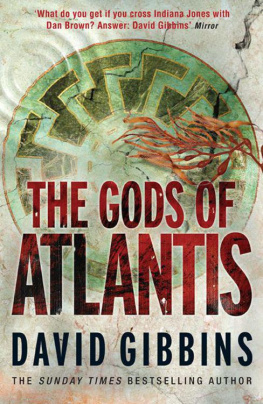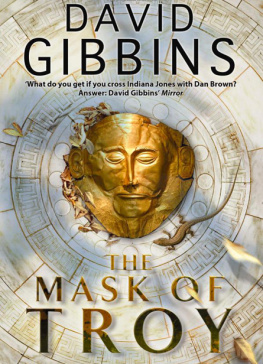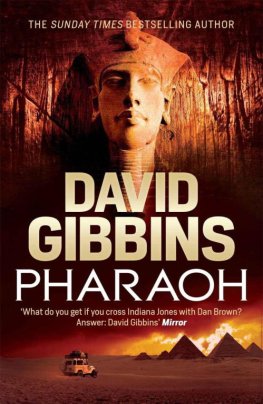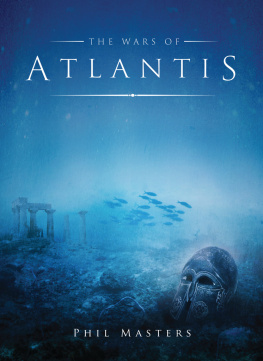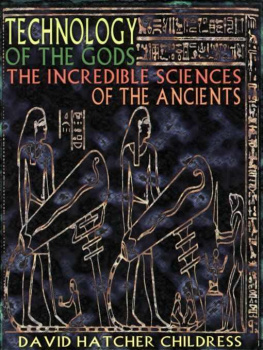David Gibbins - The Gods of Atlantis
Here you can read online David Gibbins - The Gods of Atlantis full text of the book (entire story) in english for free. Download pdf and epub, get meaning, cover and reviews about this ebook. year: 2011, publisher: Headline Publishing Group, genre: Detective and thriller. Description of the work, (preface) as well as reviews are available. Best literature library LitArk.com created for fans of good reading and offers a wide selection of genres:
Romance novel
Science fiction
Adventure
Detective
Science
History
Home and family
Prose
Art
Politics
Computer
Non-fiction
Religion
Business
Children
Humor
Choose a favorite category and find really read worthwhile books. Enjoy immersion in the world of imagination, feel the emotions of the characters or learn something new for yourself, make an fascinating discovery.
- Book:The Gods of Atlantis
- Author:
- Publisher:Headline Publishing Group
- Genre:
- Year:2011
- Rating:5 / 5
- Favourites:Add to favourites
- Your mark:
- 100
- 1
- 2
- 3
- 4
- 5
The Gods of Atlantis: summary, description and annotation
We offer to read an annotation, description, summary or preface (depends on what the author of the book "The Gods of Atlantis" wrote himself). If you haven't found the necessary information about the book — write in the comments, we will try to find it.
The Gods of Atlantis — read online for free the complete book (whole text) full work
Below is the text of the book, divided by pages. System saving the place of the last page read, allows you to conveniently read the book "The Gods of Atlantis" online for free, without having to search again every time where you left off. Put a bookmark, and you can go to the page where you finished reading at any time.
Font size:
Interval:
Bookmark:
Atlantis
Crusader Gold
The Last Gospel
The Tiger Warrior
The Mask of Troy
The Gods of Atlantis
The Gods of Atlantis
DAVID GIBBINS

Copyright 2011 David Gibbins
The right of David Gibbins to be identified as the Author of the Work has been asserted by him in accordance with the Copyright, Designs and Patents Act 1988.
Apart from any use permitted under UK copyright law, this publication may only be reproduced, stored, or transmitted, in any form, or by any means, with prior permission in writing of the publishers or, in the case of reprographic production, in accordance with the terms of licences issued by the Copyright Licensing Agency.
First published as an Ebook by Headline Publishing Group in 2011
This is a work of fiction. Names, characters, institutions, places and incidents are creations of the authors imagination and are not to be construed as real. Any resemblance to actual or other fictional events, locales, organisations or persons, living or dead, is entirely coincidental. The factual backdrop is discussed in the authors note at the end.
Cataloguing in Publication Data is available from the British Library
eISBN: 9780755374328
HEADLINE PUBLISHING GROUP
An Hachette UK Company
338 Euston Road
London NW1 3BH
www.headline.co.uk
www.hachette.co.uk
David Gibbins has worked in underwater archaeology all his professional life. After taking a PhD from Cambridge University he taught archaeology in Britain and abroad, and is a world authority on ancient shipwrecks and sunken cities. He has led numerous expeditions to investigate underwater sites in the Mediterranean and around the world. He currently divides his time between fieldwork, England and Canada.
I am very grateful to my agent, Luigi Bonomi of LBA, and to my editors, Martin Fletcher in London and Caitlin Alexander in New York; to Emily Griffin for helping to get this book into production, and to Jane Selley for her skilled copy-editing of this and my previous books; to the rest of the excellent team at Headline, including Aslan Byrne, Darragh Deering and Jane Morpeth; to the Hachette representatives internationally who have done so much to promote my books; to Alison Bonomi, Amanda Preston and Ajda Vucicevic at LBA; to Nicky Kennedy, Sam Edenborough, Mary Esdaile, Jenny Robson and Katherine West at the Intercontinental Literary Agency; to Gaia Banks at Sheil Land; to my film agent John Rush; and to Harriet Evans, my former editor at Headline, whose huge enthusiasm for my first novel Atlantis led me to think of writing the sequel that has become The Gods of Atlantis.
I am grateful to my mother Ann Verrinder Gibbins for casting a critical eye over many draft chapters and manuscripts; to my brother Alan for diving with me in lava tubes off volcanoes, for his photography and video work for my website www.davidgibbins.com and for his expertise as a pilot, greatly benefiting the flying chapters in this book; and to Angie Hobbs for her unrivalled knowledge of Plato.
Among many others who have provided helpful comments on my books I am especially grateful to Professor Paul Cartledge of Cambridge University. The research behind the first part of this book owes much to former professors and colleagues at Bristol, Cambridge and Liverpool Universities, where I was fortunate to study and to teach in institutions that have been at the forefront of research into the Neolithic in Anatolia; I would especially like to thank James Macqueen, who introduced me in riveting fashion to ancient Near Eastern civilization when I was an undergraduate at Bristol, and to the British Institute of Archaeology at Ankara for first enabling me to visit the site of atalhyk in Turkey in 1984.
Finally, to Angie and our daughter Molly, to whom all of my books are dedicated with much love.

In 1934, Heinrich Himmler the second most powerful man in Nazi Germany bought Wewelsburg Castle, a medieval stronghold perched high above the valley of the River Oder in Westphalia. Himmler associated the region with the mythic origins of the German nation, and saw the castles triangular shape as a spear of destiny, pointing north. The castle had a sinister history: legend held that thousands of accused witches were tortured and executed there, and an inquisition room still survived in the basement. But nothing in its past could equal the plans that Himmler had for it.
He set about transforming Wewelsburg into the order-castle of the SS, the ideological centre of the Nazi cult. Slave labourers were brought to a new concentration camp near the castle, and over a thousand of them were worked to death quarrying and transporting stone. A circular chamber was created, the SS Generals Hall. In the centre of the floor was a twelve-spoked sunwheel, leading out to twelve pillars and twelve window ninches. Directly below lay another chamber, a domed vault based on the tombs of the Bronze Age Mycenaeans, and a semi-mythical ruler Himmler admired Agamemnon, the Mycenaean conqueror of Troy. At the zenith of the dome was an ancient symbol that had been found on pottery at Troy and on golden decorations at Mycenae, a symbol the Nazis expropriated for their own baleful ends the crooked cross, the swastika.
What went on in those rooms may never be known. Wewelsburg became a focus for Nazi archaeological research, to fulfil Adolf Hitlers desire to return to the source of the blood, to root us again in the soil, to seek again for strength from sources which have been buried for 2,000 years. Yet Hitler himself never visited the castle. It was to remain Himmlers preserve, central to his obsession with prehistory and the occult. From there, the Ahnenerbe the Department ofCultural Heritage sent expeditions to Tibet, to Peru, to Iceland, to places still unknown today, searching for Aryan origins and for the greatest prize of all, the lost civilization of Atlantis. Underlying everything lay Himmlers racial theories, and Wewelsburg became a springboard for some of the greatest crimes against humanity ever conceived. It was there that he began to formulate the Final Solution, the mass murder of the Jews. And it was there in 1941 that he assembled his top SS generals for ideological strengthening before the invasion of Russia, the most destructive military campaign in history one foretold to Himmler in a legend of a final battle between West and East, and fuelled by his doctrine of Aryan racial superiority over the Slavic peoples of Russia.
Yet even while these terrible events were unfolding, Himmler continued to be obsessed with the symbols and artefacts of the past. He envisaged Wewelsburg Castle within a huge semicircular complex, the Centre of the New World, its plan reminiscent of the circular prehistoric monuments that he associated with mythical Aryan forebears. He planned a huge archaeological collection at Wewelsburg, to make it part of SS indoctrination. The placing of the sunwheel and the swastika in the Generals Hall and the vault below show how he drew power from ancient symbols, and incorporated them into the very core of Nazi ideology. And just as he saw those prehistoric monuments as evidence of a new order, of a new race arisen, so he saw his new world as one where the only gods were the gods of the Nazis, the gods they themselves had become.
Nobody knows how close Himmler may have come to realizing his dream, and what artefacts may have been brought there. Deep within the castle lay another chamber, Himmlers private vault, but when American soldiers captured Wewelsburg in 1945 they found it empty, its contents unknown and seemingly lost forever to history.
Font size:
Interval:
Bookmark:
Similar books «The Gods of Atlantis»
Look at similar books to The Gods of Atlantis. We have selected literature similar in name and meaning in the hope of providing readers with more options to find new, interesting, not yet read works.
Discussion, reviews of the book The Gods of Atlantis and just readers' own opinions. Leave your comments, write what you think about the work, its meaning or the main characters. Specify what exactly you liked and what you didn't like, and why you think so.

